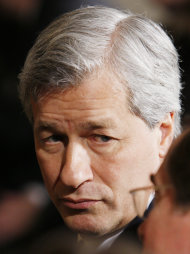
The CEO of a big bank says a U.S. default could be catastrophic for the economy. The head of the Federal Reserve warns of chaos. And a credit rating agency threatens to take away the country's coveted triple-A status.
The response on Wall Street: So what?
In Washington, the fight over whether to raise the federal debt limit has grown uglier by the day. The White House says the limit must be raised by Aug. 2 or the government won't be able to pay its bills, possibly including U.S. bonds held around the world.
But as the deadline nears, stocks and bonds have barely flinched.
The Dow Jones industrial average fell just 54 points Thursday and stands about where it did at the start of the month. The yield on the 10-year Treasury bond, which usually rises when investors see it as a riskier bet, is considerably lower than earlier this year.
It may seem an odd, even reckless, reaction by investors. But it isn't completely crazy.
Take the ho-hum reaction from the bond market. In theory, investors in U.S. Treasury bonds should demand higher interest payments when there's a greater risk they won't get their money back — in this case, in the event of a default next month.
Instead, the yield on the 10-year Treasury note rose only slightly Thursday, to 2.95 percent. In February, when the U.S. economic recovery seemed stronger and the debt limit was a distant threat, it was 3.74 percent.
But in this market, as in the schoolyard, size wins. The U.S. has $14 trillion in outstanding Treasury bonds. That dwarfs government bonds of any other nation. U.S. debt is held more widely and traded more often than any other government's IOU.
That matters because pensions, private investment funds and central banks the world over want to know that they can buy and sell these holdings fast — what investors call liquidity. During the credit crisis of 2008, investors bought U.S. Treasurys because they were perceived as not only safe but liquid.
"It's very nice that Switzerland is a safe place," says Avi Tiomkin, a hedge fund consultant who holds Treasurys. "But if you're the Russian or Chinese central bank, it's just too small."
Steve Ricchiuto, chief economist at Mizuho Securities, points to another reason the markets are calm: The U.S. may seem a more dangerous place to park your money given its rising debt, but much of the rest of the world isn't faring well, either.
He notes that Europe is trying to contain a debt crisis. Yields on bonds of various countries there have gone up recently. "The U.S. is the best in a bad world," he says, so people have no choice but to invest here.
As for stocks, there's plenty of news — some very good — to distract investors from Washington's problems. U.S. companies are issuing their financial results for the latest quarter, and they're expected to post big profits — up 15 percent, according to a survey by data provider FactSet.
JPMorgan Chase reported profits up 13 percent Thursday, higher than analysts had expected. The stock rose sharply on the news. Earlier in the day, it was that bank's CEO, James Dimon, who warned that a failure by Congress to agree to raise the debt ceiling could mean "catastrophe."
On Wednesday, Moody's Investors Services warned it might take away the United States' top-notch credit rating if it missed even one interest payment on its bonds. In testimony before Congress on Thursday, Federal Reserve Chairman Ben Bernanke said a U.S. default could throw the financial system into "chaos."
The Dow Jones industrial average closed at 12,437, down 0.4 percent. The S&P 500 closed at 1,308, down 0.7 percent.
The United States hit its current $14.3 trillion debt ceiling in May. For a new debt ceiling to last to the end of 2012 would require raising it by about $2.4 trillion.
A default would drive up the cost of government borrowing for years to come. That would translate into higher interest rates for everybody else, making it more expensive for corporations to finance spending projects and for Americans to take out mortgages or other loans.
The bigger fear is that a default could freeze the short-term lending markets that keep money moving throughout the global financial system. Treasurys and other government-backed debt are the most widely used collateral for loans in these markets.
A default and a downgrade of U.S. debt would lower the value of that collateral. Lenders might respond by forcing borrowers to sell other assets to post more collateral. The fallout could resemble what happened when Lehman Brothers collapsed in 2008.
The prospect of such terrible consequences may be exactly the reason investors aren't all that worried.
"There's just too much at stake politically and economically for a deal not to get done," says John Briggs, Treasury strategist at the Royal Bank of Scotland. "It seems hard to believe that any politician would want their name attached to a default of U.S. debt."
Many other investors are assuming the same thing. Tony Crescenzi, market strategist at money manager Pimco, says Wall Street has been expecting a deadline-beating deal since the debt-limit became a subject of debate earlier this year.
No one knows how close Washington can get to the deadline without triggering a sell-off. Sam Yake, an stock analyst at BGB Securities, is confident a deal will be struck. But he says that if enough investors start to worry, the fear could feed on itself.
"In financial markets, you're playing with people's confidence," he says. "If enough people start thinking it's a catastrophe, it could become so."


